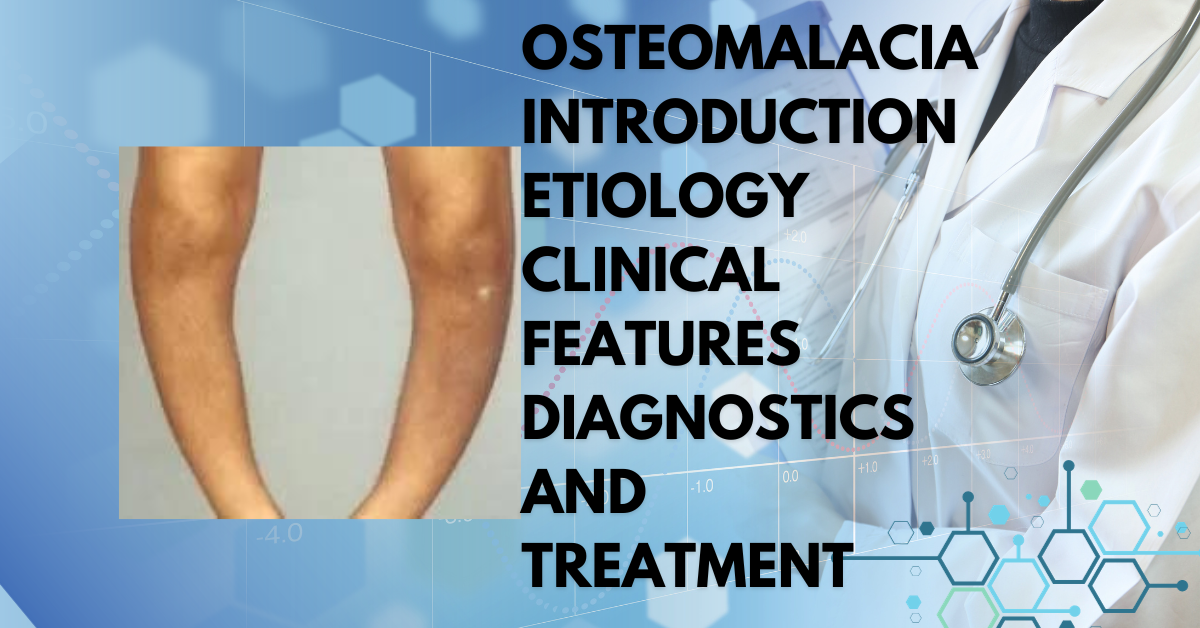Brief Introduction:
- Osteomalacia and rickets involve bone mineralization disorders.
- Osteomalacia results from defective remodeling of existing bone, while rickets are due to a deficiency in new bone formation.
- Osteomalacia can affect individuals of any age, while rickets is limited to children with open growth plates.
- Both conditions are linked to insufficient calcium, phosphate depletion, and direct inhibition of bone mineralization.
- Vitamin D deficiency is the primary cause of osteomalacia and rickets.
- Osteomalacia patients typically experience bone pain and tenderness.
- Rickets patients often exhibit bone deformities and impaired growth.
- Over time, both conditions can lead to long bone curvature and pathological fractures.
- Diagnosis relies on clinical history, and abnormal lab results, and often includes imaging.
- Treatment aims to address the underlying cause, usually focusing on treating vitamin D deficiency and ensuring sufficient calcium intake.
Etiology
- Insufficient Calcium (Calcipenic Rickets)
- Vitamin D deficiency (most common cause)
- Vitamin D-dependent rickets type 1
- Vitamin D-dependent rickets type 2
- Calcium deficiency and other causes of hypocalcemia
- Phosphate deficiency (phosphopenic rickets)
- Renal phosphate wasting due to renal tubular defects (e.g., distal renal tubular acidosis, Fanconi syndrome)
- Chronic use of phosphate binders
- Other causes of hypophosphatemia, e.g.:
- Hereditary hypophosphatemic rickets
- Tumor-induced osteomalacia
- Direct inhibition of bone mineralization
- Medications, e.g., bisphosphonates, aluminum, fluoride
- Hereditary hypophosphatasia
Most Common Cause of Osteomalacia and Rickets:
- Vitamin D Deficiency is the primary and most prevalent cause for both conditions.
Less Common Causes:
- Vitamin D-independent causes, including hypophosphatemia, hypocalcemia, and medication-induced factors, are less frequently observed.
- Hereditary factors also contribute to a smaller proportion of cases.
Pathophysiology
Mechanisms of Osteomalacia and Rickets:
- Calcipenic Rickets:
- Decreased Calcium Levels → Elevated PTH (Parathyroid Hormone) Levels → Reduced Phosphate → Impaired Bone Mineralization
- For further details, refer to “Calcium Homeostasis.”
- Phosphopenic Rickets:
- Decreased Phosphate Levels → Impaired Bone Mineralization
- Direct Inhibition of Mineralization: Results in Impaired Bone Mineralization
Effects of Impaired Bone Mineralization:
- Impaired bone mineralization can impact both the existing bone matrix (osteomalacia) and, if the growth plates are still open, the formation of new bone (rickets).
- Low phosphate levels are a common factor in both calcipenic and phosphopenic forms of osteomalacia and rickets.
Clinical Features:
Osteomalacia:
- Occurs in both adults and children.
- Symptoms:
- Bone pain and tenderness.
- Pathologic fractures.
- Myopathy, predominantly proximal.
- Muscle weakness leading to a waddling gait and difficulty walking.
- Spasms and cramps.
- Symptoms of hypocalcemia.
- Severe osteomalacia can lead to bone deformities, such as bowing of the lower limbs.
- Note: Osteomalacia and rickets may sometimes be asymptomatic.
Rickets:
- Occurs exclusively in children, as their growth plates have not fused.
- Clinical signs include:
- Bone deformities, primarily bowing of the long bones.
- Distention of the bone-cartilage junctions.
- Rachitic rosary: bead-like distention of the bone-cartilage junctions in the ribs.
- Marfan sign: Distention of the epiphyseal plate of the distal tibia with widening and cupping of the metaphysis, giving the appearance of a double medial malleolus on inspection and palpation of the ankle.
- Widened wrists.
- Craniotabes: softening of the skull.
- Deformities of the knee, especially genu varum.
- Increased risk of fracture.
- Harrison groove: A depression of the thoracic outlet caused by muscles pulling along the costal insertion of the diaphragm.
- Impaired growth.
- Symptoms of hypocalcemia, including seizures in infants.
- Late closing of fontanelles.
- Delayed walking (beyond 18 months).
- Cardiomyopathy.
Important Note:
- Osteomalacia is characterized by defective mineralization of existing bone and can occur in individuals with open or closed growth plates.
- Rickets involves defective mineralization of new bone formation and, therefore, only occurs in children with open growth plates, typically before the end of puberty.
Subtypes and Variants
Vitamin D-dependent rickets type 1:
- Pathophysiology:
- Autosomal recessive mutation in the 25-hydroxyvitamin-D-1α-hydroxylase gene.
- Results in impaired conversion of inactive vitamin D to the active form, 1,25‑dihydroxyvitamin D3 (calcitriol).
- Clinical features:
- Early onset of rickets (in infancy).
- Muscle weakness.
- Growth faltering.
- Hypotonia.
- Pathological fractures.
- Diagnostics:
- Normal or elevated plasma 25-OH.
- Low or undetectable 1,25(OH)2D.
- Hypocalcemia, hypophosphatemia, and elevated ALP (alkaline phosphatase).
- Elevated parathyroid hormones.
- Treatment:
- Calcitriol supplementation.
Vitamin D-dependent rickets type 2:
- Pathophysiology:
- An autosomal recessive mutation in the vitamin D receptor gene causes end-organ resistance to vitamin D.
- Clinical features:
- Early onset of rickets (in infancy).
- Growth faltering.
- Alopecia (hair loss).
- Diagnostics:
- Normal or elevated plasma 25-OH.
- Extremely elevated plasma 1,25(OH)2D.
- Hypocalcemia, hypophosphatemia, elevated ALP.
- Elevated parathyroid hormones.
- Treatment:
- Very high-dose vitamin D therapy.
- In cases of refractory disease, elemental calcium may be required.
Diagnostics
General Principles:
- Diagnosis is primarily based on characteristic laboratory and imaging findings.
- In cases of diagnostic uncertainty, consider referring patients to endocrinology for advanced studies.
Laboratory Studies:
- Common laboratory findings in vitamin D deficiency include:
- Decreased serum calcium (↓ Ca)
- Decreased phosphorus (↓ phosphorus)
- Increased parathyroid hormone (↑ PTH)
- Increased alkaline phosphatase (↑ ALP)
- If laboratory findings are not consistent with osteomalacia/rickets, refer to “Laboratory evaluation of bone disease.”
Laboratory Findings in Osteomalacia and Rickets by Etiology:
- Calcipenic Rickets:
- Serum calcium: Initially normal or decreased (↓)
- Serum phosphorus: Initially normal or decreased (↓)
- Urine calcium: Decreased (↓)
- Urine phosphorus: Variable
- ALP: Increased (↑)
- Parathyroid hormone (PTH): Increased (↑)
- Serum 25-OH (vitamin D levels): Decreased (↓) or normal
- Phosphopenic Rickets:
- Serum calcium: Normal or increased (initially)
- Serum phosphorus: Decreased (↓)
- Urine calcium: Variable
- Urine phosphorus: Increased (↑) unless dietary phosphate deficiency
- ALP: Increased (↑)
- Parathyroid hormone (PTH): Normal
- Serum 25-OH (vitamin D levels): Normal
Imaging:
Imaging findings in osteomalacia and/or rickets may include:
- General:
- Evidence of bone loss.
- Decreased bone mineral density, resulting in osteopenia or osteoporosis.
- Thinning of the cortical bone.
- Pathological Fractures: Occur due to weakened bone.
- Looser Zones (Pseudofractures):
- Evidence of bone loss.
- These are characteristic radiolucent bands representing insufficiency stress fractures seen in osteomalacia and severe rickets.
- Typical features of Looser zones include:
- Multiple and symmetrical distribution.
- Perpendicular orientation to the periosteal surface.
- Most often located in the ribs, scapulae, pubic rami, and medial cortex of long bones.
- Additional Findings in Rickets:
- Epiphyseal Plate Widening: Widening of the growth plate regions.
- Metaphyseal Changes: Cupping, stippling, and fraying in the metaphysis.
- Bone Bowing: Seen in conditions like genu varum (bow legs).
- Chest X-ray: Prominent costochondral junctions of the ribs, known as the rachitic rosary.
- X-ray of the Skull: Persistently widened suture lines (open fontanelles), occipital flattening, and a more squared appearance.
- X-ray of the Spine: Spinal curvature can be observed.
- Additional Findings in Osteomalacia:
- Increased Uptake on Bone Scintigraphy:
- Due to increased bone turnover.
- This can sometimes mimic metastatic cancer.
- Increased Uptake on Bone Scintigraphy:
Advanced Studies:
- Indications for advanced studies include diagnostic uncertainty and when rare etiologies are suspected, such as tumor-induced osteomalacia or vitamin D-dependent rickets type I or type II.
- Potential advanced studies may involve serum 1,25(OH)2D levels, FGF23 levels, and iliac bone biopsy with tetracycline labeling.
Treatment
General Principles:
- Treat any acute electrolyte abnormalities, such as:
- Calcium repletion for severe and/or symptomatic hypocalcemia.
- Phosphate repletion.
- Review the patient’s diet and medication list to identify reversible causes of osteomalacia and rickets.
- Determine the underlying etiology, and if necessary, refer the patient to a specialist for further management.
- For persistent bone deformities that do not respond to medical management, consider referring the patient to orthopedics for potential surgical correction.
Treatment of Vitamin D-Associated Osteomalacia and Rickets:
- Pharmacological Therapy:
- Administer treatment doses of vitamin D as appropriate.
- Ensure adequate daily intake of calcium.
- In selected cases, calcitriol may be required for specific indications.

